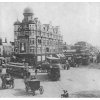Wonderful Thread. Some really splendid pictures I hadn't seen before. About a year ago I emailed the southwark local history library asking about Elephant and Castle history (both topographical, etymological and iconographic aspects). I got the most marvellously comprehensive and detailed email back. Here are some quotes:
"The Elephant and Castle Public House goes back only to the mid-18th century. The big junction that we now call the Elephant and Castle was referred to as Newington or Newington Butts in the 18th century and earlier. It was the centre of the parish and village of St. Mary, Newington Butts, and was the first distinct place out of London (and, of course, out of Southwark) on the old Portsmouth Road.
The pub was previously occupied by a farrier's. [A farrier is a specialist in equine hoof care, including the trimming and balancing of a horse's hoof and the placing of shoes to the horse's foot]. In fact, it seems very likely that the first Elephant and Castle Public House occupied the same building that had been the farrier's, which had used the name and sign of the White Horse from the late 17th century onwards. The pub first appears in written history under its familiar name in 1765.
Almost certainly, the change from farrier's to pub relates to the opening of New Kent Road under an Act of 1751. The evidence suggests that the change of function and name may have taken place as early as 1755.
As for the wider story of the Elephant and Castle sign, it was the case as early as the 11th century that any depiction of an elephant - in carvings of wood or stone, and paintings as in bestiaries - always involved a 'castle'. In the simplest sense, this was just an elephantine version of a horse's saddle. A horse would normally have just one rider on a saddle, but an elephant could take several. In the mediaeval mind, in view of the use of elephants in warfare, the elephantine saddle inevitably became a 'castle'; in art, this element became more pronounced than it was in reality. The warriors did need protection, of course. And that reflection of the military use of elephants went back to Hannibal* and perhaps beyond. The ancient Roman
world was certainly well aware of the elephant in warfare, which was in turn translated into the conventional idea of the elephant and castle in the Middle Ages. From that time onwards, elephants were almost always depicted in that guise.
The sign is a fairly common one for pubs. There used to be another exmple at Vauxhall**, about a mile and a half from Newington, and a further case just across Westminster Bridge. Across England, the tally is several dozen. The oddity of the case, I always think, is why people consider that the one at Newington has to have a special explanation. Mere prominence, I suppose."
I will credit these quotes to their most generous author: Stephen Humphrey, who is an Archivist at the southwark local history library.
[email protected]
I reccommend emailing them for any queries you have about local history. They are simply amazing.
*I noticed that the office block building above the northernline tube entrance is called Hannibal House. Don't know if this is deliberate?
**Still there last time I looked, above the Starbucks. Visible from the ground but best viewed from the mainline train platform.







 ,cycle through the area on me way to work every day,shabby as the shopping centre is,Ive got a soft spot for the aul place,all human life and all that
,cycle through the area on me way to work every day,shabby as the shopping centre is,Ive got a soft spot for the aul place,all human life and all that










